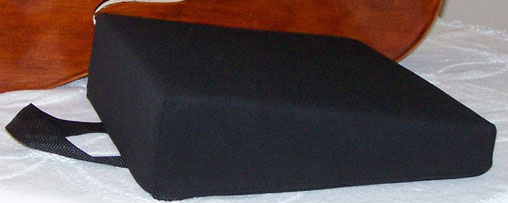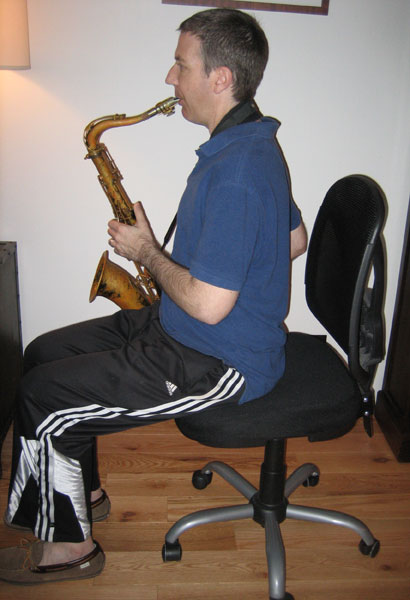Finding the Best Way to Play Saxophone When Sitting Down

Editor’s Note: This article was inspired by a question I recently received from a reader. It’s actually a great question, and I thought that it would be a fantastic opportunity to tap into the wisdom of Bill Plake. Some of you may recognize Bill as one of the contributors to the Bulletproof Saxophone Playing program. At any rate, he’s a leading Alexander Technique educator – which, in a nutshell, means that he’s an expert in the realm of helping you achieve ease and efficiency of movement, enhanced balance and coordination, improved vocal and respiratory function, and a more reliable sensory perception. You can read more about Bill and the Alexander Technique here.
– Doron
“Is there a correct, proper, or specific chair that you can recommend to practice saxophone? Right now I am using one of those metal folding chairs with a cushion to make it a bit more comfortable, but it is still uncomfortable. Can you give me any suggestions?”
– Harold Pizer
I think the three most important things here are:
- The saxophonist sitting in good balance
- The chair having the optimum height and surface
- The saxophonist taking adequate rest away from the chair during practice
What’s your Angle?
To play well when seated we need to be on our sitting bones (those two bony protrusions at the bottom of your pelvis) with our necks releasing our heads directly above the pelvis. So no slouching, no overly-straight hyperextension; just simple, easy poise. The height of the chair needs to be one such that our knees are slightly lower than our hips. A good angle between the torso and legs might be 130 degrees or so (as opposed to 90 degrees, or worse, even less). A stool works very well for playing saxophone. It is what I use when I sit to play.
Maintaining an angle of 130 degrees between the torso and the legs is optimal since it tends to open up the hip joints, making it easier to sit in upright balances without over-engaging the hip flexors (the muscles on the front side of the thigh) and without over-engaging the lower back muscles. It is akin to sitting in a kneeling position minus the pressure on the knees, which is very nice for the head, neck, and back (ever seen one of those kneeling computer chairs?)

It’s the Surface Stuff that Matters
That brings me to the sitting surface. It needs to be firm, but not uncomfortable. I actually like using a stool with a wooden seat, but many folks prefer more padding. The firmness of the surface helps to put optimum pressure on the sitting bones, which in turn, naturally send us upright into good balance (again, the importance of letting the head balance on top of the spine above the sitting bones).
Good Things to Sit On
Most saxophonists practice in chairs that are too low for them (less than 90 degree angle between torso and legs) and too soft – inviting them to collapse into compression. If you’re going to sit in, let’s say, a folding chair, consider raising the height of the chair. Placing a zafu (Japanese mediation cusion) on top of a chair’s seat is a very good option here. It’s also a great surface because it is firm but quite comfortable. My Alexander students love them.
Another very good option is something called a Cello Seat Cushion, which is a very firm foam pad in the shape of a wedge that is slightly higher in the back than the front. Both the zafu and the cello seat cushion can be found online, although I think the cello seat cushion is only available through one website (http://www.celloseatcushions.com). Zafus you can find anywhere. Amazon has them. Just make sure that the Zafu has a cotton cover, not silk, and that it is filled with genuine buckwheat kernels, not synthetic.
I’m stating the obvious here, but chairs tend to come in similar, standard heights, but people come in all different heights. Sometimes I think of chairs as “one size fits none”. So the chair height is dependent on the height and proportions of the saxophonist, and needs to be adjusted accordingly.
Keep it Movin’
Finally, the saxophonist has to move from time to time, no matter how good the sitting situation is. Vary your position slightly from time to time during your practice session, still aiming toward balance and poise, and try not to stay seated for more than 45 minutes at a stretch without taking a break.
So to sum up, it starts with the good postural habits of the saxophonist, supported by the chair with the best height and surface, tempered by the habit of changing positions and taking adequate rest.






March 27, 2012 @ 5:03 pm
Great article! This addresses a problem I have had since I started playing in a concert band. I am an alto sax player and I have settled on what some may call an odd playing position. I sit towards the front of my chair with my right leg hanging off the right side. I position my horn right in the middle and I tend to move side to side slightly as I play. I don’t know if this works well for anyone else.
March 27, 2012 @ 5:21 pm
Carl, the most important thing is that you sit in easy and upright balance. It works well for many saxophonists to angle the chair so that they are sitting on the corner of the chair. It’s also okay to have your feet in different positions (some players like to bring the right leg back a bit). The bottom line is that you should be able to sit without creating distortion of your spine and general compression of your bodily structure (which not only can cause pain, discomfort and/or injury, but also, can interfere with the use of your arms, hands and breathing). So it’s fine to sit in what some might call “an odd playing position”, so long as your in good, easy balance.
April 8, 2012 @ 6:10 am
Excellent. Every student should print out this article and hang it on the wall of their practice space. I had a major problem with my right hand due to years of playing in an improper position. It took me many months to correct. http://www.youtube.com/watch?v=8BkIUTpwgbk
March 27, 2024 @ 2:44 pm
Well, this is 12 years later, but here goes:
I normally practice standing up;. I’m 6’6″. When I practice sitting, I use my Roc-N-Soc high version, hydraulic drum throne, round seat. It’s great. Angle is slightly tilted.
However…
I live in a small studio apartment in LA currently, and I can only get away with a little practice there, for obvious reasons. So, I’m shopping for a vheicle (which I need anyway out here to go to jam sessions, etc.) that I can practice in.
Back in NY state, I have an old “turtle top” van that is great for this, but it needs to stay there for use there, and they are not only scarce out here (because people live in them) but also get only about 13 mpg, which isn’t ideal when gas is $6 a gallon.
But there is nothing on the market that is remotely close. Ford Transit, etc. all top out at 49″ height in the cargo area. OK, the BIG Transits (Amazon delivery size) are 6 feet! But then you’re driving around in a $25,000 giant tin can… And they make even bigger ones…
So I found your article wondering whether I could get away with a Honda Element, Ford Transit Connect, Dodge Promaster City, or similar smaller vehicle with only about 45″ – 49″ of height available. That would mean sitting on a low stool with my legs straight out or on a slight angle ((like sitting in a chair normally with one’s feet on a footstool).
I think it would be *doable*, but only for short periods of time. And I think it may cause back issues. Plus, the horn would be on the right side of my right leg, neck turned, Lester Young style a bit.
What are your thoughts? Bite the mpg bullet and get another conversion van?
Thanks, great article!
– Jeffrey Newton
April 8, 2012 @ 10:09 am
Thanks, John. I’m glad you found the article useful. I myself had serious problems with my left hand because of harmful postural and movement habits (that’s what lead me to study the Alexander Technique). A simple, yet very important thing for us all to keep in mind is that what we do with any one part of ourselves affects the other parts. We are organized as a whole, fully integrated organism. By sitting in collapse (or other types of postural distortion) we compromise the use of our hands, mouth and breath (the parts we associate with “playing the saxophone”).
June 20, 2021 @ 9:07 am
I know this is an old post, but now there is a new seat especially designed for sax players. It improves posture and takes the weight off your shoulders and back, enabling you to play or practice for much longer. Have a look here saxseat.com